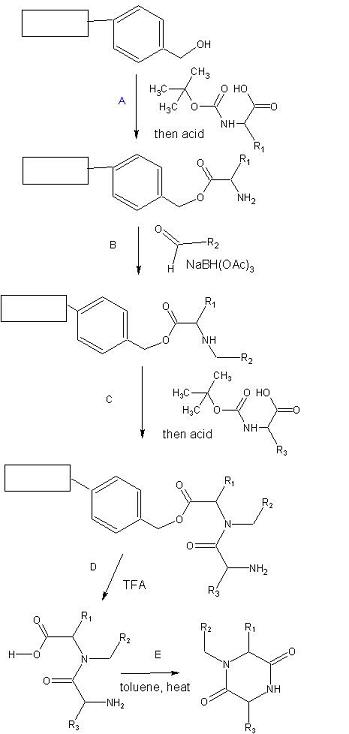Thanks to
Ruslan, we have a lookup table for the first hundred compounds in the
malaria37 batch. The first 6 have been processed so for anyone contributing to this project, feel free to add the rest in the format used
here. For some reason the SMILES codes provided by Ruslan were all set to the R configuration - I removed the "@@" characters to wipe out the stereochemical information that was not given with the original compounds.
I first tried to use the SMILES code as the name of the molecule but that made double checking against the original data too hard. So the format is just "malaria37-1". I have already uploaded all the gif files. Just link to them from the blog using this format: "http://showme.physics.drexel.edu/bradley/malaria37-1.gif"
Here is the lookup table:
1 "N1([CH](C(N[CH](C1=O)CCCC)=O)Cc1cc(c(cc1)O)O)C[CH]([CH](C(O)=O)Br)Br"
2 "N1([CH](C(N[CH](C1=O)CCSC)=O)Cc1cc(c(cc1)O)O)Cc1oc(cc1)C"
3 "N1([CH](C(N[CH](C1=O)CCSC)=O)[CH](c1cc(c(cc1)O)O)O)CC(=O)C"
4 "N1([CH](C(N[CH](C1=O)Cc1ccc(cc1)I)=O)CCCCNC)Cc1ccc(c(c1)O)O"
5 "N1([CH](C(N[CH](C1=O)CC(C)C)=O)Cc1cc(c(cc1)O)O)Cc1ncccc1"
6 "N1([CH](C(N[CH](C1=O)Cc1ccccc1)=O)CCCN)CC[CH]([CH](CO)O)O"
7 "N1([CH](C(N[CH](C1=O)CC)=O)Cc1cc(c(cc1)O)O)Cc1oc(cc1)C"
8 "N1([CH](C(N[CH](C1=O)Cc1sccc1)=O)CCCCN)Cc1ccc(c(c1)O)O"
9 "N1([CH](C(N[CH](C1=O)CCC)=O)[CH](c1cc(c(cc1)O)O)O)CC(=O)C"
10 "N1([CH](C(NCC1=O)=O)Cc1cc(c(cc1)O)O)C[CH]([CH](C(O)=O)Br)Br"
11 "N1([CH](C(N[CH](C1=O)CCSC)=O)Cc1cc(c(cc1)O)O)CCCC(O)=O"
12 "N1([CH](C(N[CH](C1=O)CCl)=O)Cc1cc(c(cc1)O)O)Cc1sccn1"
13 "N1([CH](C(NCC1=O)=O)CCC(=O)O)Cc1ccc(c(OC)c1)O"
14 "N1([CH](C(N[CH](C1=O)CC1CCCCC1)=O)Cc1cc(c(cc1)O)O)CC(O)=O"
15 "N1([CH](C(N[CH](C1=O)Cc1ccc(cc1)F)=O)CCCCN)Cc1ccc(c(OC)c1)O"
16 "N1([CH](C(N[CH](C1=O)CC1CCCCC1)=O)CC(=O)O)CCCc1ccc(c(OC)c1)O"
17 "N1([CH](C(N[CH](C1=O)CC(C)C)=O)Cc1cc(c(cc1)O)O)Cc1oc(CC)cc1"
18 "N1([CH](C(N[CH](C1=O)[CH](CC)C)=O)CCOCCN)Cc1ccc(c(c1)O)O"
19 "N1([CH](C(NCC1=O)=O)Cc1cc(c(cc1)O)O)Cc1nc(ccc1)C"
20 "N1([CH](C(N[CH](C1=O)CC(C)C)=O)Cc1cc(c(cc1)O)O)Cc1nc(ccc1)C"
21 "N1([CH](C(N[CH](C1=O)Cc1ccc(cc1)I)=O)CCCN)CC[CH]([CH](CO)O)O"
22 "N1([CH](C(N[CH](C1=O)CC(C)C)=O)CC(=O)O)CCCc1ccc(c(OC)c1)O"
23 "N1([CH](C(N[CH](C1=O)CCSCC)=O)Cc1cc(c(cc1)O)O)Cc1oc(c(c1)C)C"
24 "N1([CH](C(N[CH](C1=O)Cc1cc(ccc1)O)=O)CCN)Cc1ccc(cc1)O"
25 "N1([CH](C(N[CH](C1=O)CC(C)C)=O)[CH](c1cc(c(cc1)O)O)O)CC(=O)C"
26 "N1([CH](C(N[CH](C1=O)CC1CCCCC1)=O)CCCN)C[CH]([CH](CO)O)O"
27 "N1([CH](C(N[CH](C1=O)[CH](c1ccccc1)C)=O)CCCCN)Cc1ccc(c(c1)O)O"
28 "N1([CH](C(N[CH](C1=O)CCCN)=O)CO)Cc1ccc(c(c1)O)O"
29 "N1([CH](C(N[CH](C1=O)CC)=O)Cc1cc(c(cc1)O)O)Cc1occc1"
30 "N1([CH](C(N[CH](C1=O)CC)=O)Cc1cc(c(cc1)O)O)Cc1oc(cc1)Br"
31 "N1([CH](C(N[CH](C1=O)CC1CCCCC1)=O)CCCN)CC[CH]([CH](CO)O)O"
32 "N1([CH](C(N[CH](C1=O)Cc1ccc(cc1)Cl)=O)Cc1cc(c(cc1)O)O)CC(=O)C"
33 "N1([CH](C(N[CH](C1=O)CCCCCC)=O)Cc1cc(c(cc1)O)O)Cc1oc(CC)cc1"
34 "N1([CH](C(N[CH](C1=O)CC1CCCCC1)=O)Cc1cc(c(cc1)O)O)C[CH]([CH](C(O)=O)Br)Br"
35 "N1([CH](C(N[CH](C1=O)CCl)=O)CCC(=O)N)Cc1ccc(c(c1)O)O"
36 "N1([CH](C(N[CH](C1=O)CSCc1ccccc1)=O)CCCN)Cc1ccc(c(c1)O)O"
37 "N1([CH](C(N[CH](C1=O)Cc1ccccc1)=O)CCCN)Cc1ccc(c(c1)O)O"
38 "N1([CH](C(N[CH](C1=O)CCCC)=O)Cc1cc(c(cc1)O)O)Cc1oc(cc1)Br"
39 "N1([CH](C(N[CH](C1=O)[CH](c1ccccc1)C)=O)CCCCNC)Cc1ccc(c(OC)c1)O"
40 "N1([CH](C(N[CH](C1=O)CC)=O)CCC(=O)O)Cc1ccc(c(c1)O)O"
41 "N1([CH](C(N[CH](C1=O)Cc1ccc(cc1)I)=O)CCCN)Cc1ccc(c(OC)c1)O"
42 "N1([CH](C(N[CH](C1=O)CN)=O)Cc1cc(c(cc1)O)O)CC(=O)C"
43 "N1([CH](C(N[CH](C1=O)CCSC)=O)Cc1cc(c(cc1)O)O)Cc1oc(c(c1)C)C"
44 "N1([CH](C(N[CH](C1=O)CCSCC)=O)Cc1cc(c(cc1)O)O)Cc1occc1"
45 "N1([CH](C(N[CH](C1=O)Cc1ccccc1)=O)CCCN)Cc1ccc(c(OC)c1)O"
46 "N1([CH](C(N[CH](C1=O)CCSC)=O)Cc1cc(c(cc1)O)O)Cc1ncccc1"
47 "N1([CH](C(N[CH](C1=O)CCC)=O)CC[CH](CN)O)Cc1ccc(c(c1)O)O"
48 "N1([CH](C(N[CH](C1=O)CC(C)C)=O)Cc1cc(c(cc1)O)O)C[CH]([CH](C(O)=O)Br)Br"
49 "N1([CH](C(N[CH](C1=O)CCl)=O)Cc1cc(c(cc1)O)O)Cc1occc1"
50 "N1([CH](C(N[CH](C1=O)[CH](c1ccccc1)C)=O)CCCN)Cc1ccc(c(OC)c1)O"
51 "N1([CH](C(N[CH](C1=O)CC1CCCCC1)=O)Cc1cc(c(cc1)O)O)Cc1oc(cc1)C"
52 "N1([CH](C(N[CH](C1=O)CCN)=O)CO)CCCc1ccc(c(OC)c1)O"
53 "N1([CH](C(N[CH](C1=O)CCl)=O)Cc1cc(c(cc1)O)O)Cc1oc(CC)cc1"
54 "N1([CH](C(NCC1=O)=O)CCCN)Cc1ccc(c(OC)c1)O"
55 "N1([CH](C(N[CH](C1=O)[CH](c1ccccc1)C)=O)CCCN)CC[CH]([CH](CO)O)O"
56 "N1([CH](C(NCC1=O)=O)CC[CH](CN)O)CCCc1ccc(c(OC)c1)O"
57 "N1([CH](C(N[CH](C1=O)C(C)C)=O)CC[CH](CN)O)Cc1ccc(c(c1)O)O"
58 "N1([CH](C(N[CH](C1=O)[CH](O)C)=O)Cc1cc(ccc1)O)C[CH](CO)O"
59 "N1([CH](C(N[CH](C1=O)CC=C)=O)Cc1cc(c(cc1)O)O)Cc1oc(CC)cc1"
60 "N1([CH](C(N[CH](C1=O)CC(C)C)=O)CCC(=O)O)Cc1ccc(c(OC)c1)O"
61 "N1([CH](C(N[CH](C1=O)CC)=O)Cc1cc(c(cc1)O)O)Cc1oc(CC)cc1"
62 "N1([CH](C(N[CH](C1=O)CCSCC)=O)Cc1cc(c(cc1)O)O)Cc1ncccc1"
63 "N1([CH](C(N[CH](C1=O)CCC)=O)Cc1cc(c(cc1)O)O)CC(=O)C"
64 "N1([CH](C(N[CH](C1=O)CCl)=O)[CH](c1cc(c(cc1)O)O)O)CC(=O)C"
65 "N1([CH](C(N[CH](C1=O)CCCC)=O)Cc1cc(c(cc1)O)O)Cc1occc1"
66 "N1([CH](C(N[CH](C1=O)CC1CCCCC1)=O)CCC(=O)N)CC[CH]([CH](CO)O)O"
67 "N1([CH](C(N[CH](C1=O)CCCCCC)=O)[CH](c1cc(c(cc1)O)O)O)CC(=O)C"
68 "N1([CH](C(N[CH](C1=O)CCSC)=O)Cc1cc(c(cc1)O)O)CC(O)=O"
69 "N1([CH](C(N[CH](C1=O)CC1CCCCC1)=O)Cc1cc(c(cc1)O)O)CC(=O)C"
70 "N1([CH](C(N[CH](C1=O)CCC)=O)Cc1cc(c(cc1)O)O)C[CH]([CH](C(O)=O)Cl)Cl"
71 "N1([CH](C(NCC1=O)=O)CC(=O)N)Cc1ccc(c(c1)O)O"
72 "N1([CH](C(N[CH](C1=O)CC)=O)Cc1cc(c(cc1)O)O)C[CH]([CH](C(O)=O)Cl)Cl"
73 "N1([CH](C(N[CH](C1=O)CC1CCCCC1)=O)Cc1cc(c(cc1)O)O)Cc1occc1"
74 "N1([CH](C(N[CH](C1=O)CCC)=O)Cc1cc(c(cc1)O)O)Cc1oc(cc1)C"
75 "N1([CH](C(N[CH](C1=O)c1ccccc1)=O)CCCCN)CCCc1ccc(c(OC)c1)O"
76 "N1([CH](C(N[CH](C1=O)CCO)=O)Cc1cc(c(cc1)O)O)CC(=O)C"
77 "N1([CH](C(N[CH](C1=O)CC1CCCCC1)=O)CCC(=O)N)C[CH]([CH](CO)O)O"
78 "N1([CH](C(N[CH](C1=O)CC)=O)Cc1cc(c(cc1)O)O)C[CH]([CH](C(O)=O)Br)Br"
79 "N1([CH](C(N[CH](C1=O)CC1CCCCC1)=O)Cc1cc(c(cc1)O)O)Cc1sccn1"
80 "N1([CH](C(N[CH](C1=O)C(C)(C)C)=O)CC[CH](CN)O)Cc1ccc(c(c1)O)O"
81 "N1([CH](C(N[CH](C1=O)CCCCCC)=O)Cc1cc(c(cc1)O)O)Cc1occc1"
82 "N1([CH](C(N[CH](C1=O)CN)=O)CCN)Cc1ccc(c(c1)O)O"
83 "N1([CH](C(N[CH](C1=O)CC1CCCCC1)=O)Cc1cc(c(cc1)O)O)CCCC(O)=O"
84 "N1([CH](C(N[CH](C1=O)Cc1ccc(cc1)I)=O)CCCCN)Cc1ccc(c(c1)O)O"
85 "N1([CH](C(N[CH](C1=O)CCCCNC)=O)Cc1cc(c(cc1)O)O)CC(=O)C"
86 "N1([CH](C(N[CH](C1=O)CC[S](=O)C)=O)CCN)Cc1ccc(c(c1)O)O"
87 "N1([CH](C(N[CH](C1=O)CCCC)=O)Cc1cc(c(cc1)O)O)Cc1oc(c(c1)C)C"
88 "N1([CH](C(N[CH](C1=O)CC(C)C)=O)Cc1cc(c(cc1)O)O)CC(O)=O"
89 "N1([CH](C(N[CH](C1=O)C)=O)Cc1cc(c(cc1)O)O)Cc1nc(ccc1)C"
90 "N1([CH](C(N[CH](C1=O)CCCCCC)=O)Cc1cc(c(cc1)O)O)Cc1oc(cc1)C"
91 "N1([CH](C(N[CH](C1=O)CSC)=O)Cc1cc(c(cc1)O)O)Cc1oc(c(c1)C)C"
92 "N1([CH](C(N[CH](C1=O)CCCC)=O)Cc1cc(c(cc1)O)O)Cc1sccn1"
93 "N1([CH](C(N[CH](C1=O)CCCN)=O)Cc1cc(c(cc1)O)O)CC(=O)C"
94 "N1([CH](C(N[CH](C1=O)CC(C)C)=O)Cc1cc(c(cc1)O)O)Cc1sccn1"
95 "N1([CH](C(N[CH](C1=O)CCSCC)=O)Cc1cc(c(cc1)O)O)Cc1nc(ccc1)C"
96 "N1([CH](C(N[CH](C1=O)CC1CCCCC1)=O)CCCN)C[CH]([CH]([CH](CO)O)O)O"
97 "N1([CH](C(N[CH](C1=O)C(C)(C)C)=O)CCC(=O)O)Cc1ccc(c(c1)O)O"
98 "N1([CH](C(N[CH](C1=O)CCSC)=O)Cc1cc(c(cc1)O)O)Cc1oc(CC)cc1"
99 "N1([CH](C(N[CH](C1=O)CC1CCCCC1)=O)CC[CH](CN)O)C[CH]([CH](CO)O)O"
100 "N1([CH](C(NCC1=O)=O)Cc1cc(c(cc1)O)O)CCCC(O)=O"






